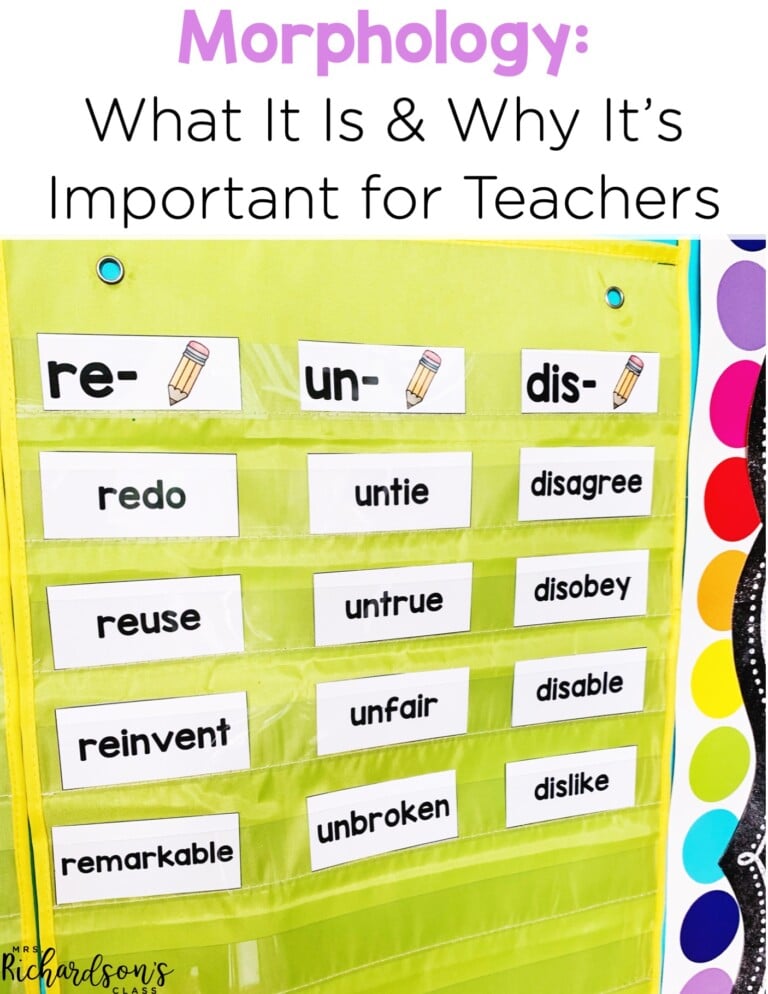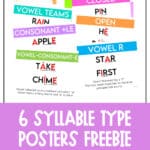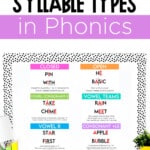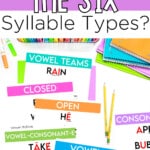


I remember seeing the decoding gaps of some of my students during my first year of teaching. A lot of them didn’t know their letter sounds, so they definitely didn’t know the different types of syllables. Goodness, I think I barely knew the six different types of syllables! If they did know their letter sounds, they didn’t know when to use the short sound of a vowel versus using the long sound. I would quickly teach them during guided reading, but I quickly realized this was a whole class problem.
To be honest, I didn’t receive a lot of phonics instruction when I was in school, so I was a little lost at where to start. I remember going next door to a teaching friend’s classroom and observing her teach phonics. I was blown away! When I started implementing what I learned and simply teaching things explicitly as the (what I thought was boring) basal reader suggested, I saw lots of growth in their decoding abilities.
Do you teach the six types of syllables at your school? Are you new to the syllable types? If so, you’re not alone. We’ll cover everything you need to know to get started with teaching your students this important skill.
A syllable is a unit of pronunciation that has one vowel sound in it. Every syllable is pronounced with one sound of your voice. Some words only have one syllable (take), while other words have three or even four syllables like the word (al/li/ga/tor).
You will need your students to be familiar with and understand how to find the number of syllables in a word before you begin teaching them about the six syllable types. This is something that I knew was important, but I couldn’t put together WHY it was such a foundational skill.
There are so many ways to have students practice finding how many syllables are in a word. You can clap words together, have them put their hand under their chin as they say a word, or you can look for syllable games online.
You can also look at the word visually and determine the number of syllables. To do this, you have to look at how many vowel sounds are in the word, not just how many vowels you see. This can be tricky for some of our littlest learners.
Once your students can identify the number of syllables in a word, you are ready to teach them the six syllable types.
There are six types of syllables:
Let’s chat about each one real quick so you get a full understanding of how to define each one.
These syllables have a vowel followed by a consonant. There can be one or two consonants (i.e. a blend or digraph) after the vowel. In these syllables, the vowel makes a short sound. Some examples include cat, with, back, and pin.
These syllables end in a vowel. The vowel makes the long sound in these syllables. Open syllables can be single syllable words or multisyllabic words. Examples include he, human, so, and basic.
This type of syllable is a vowel followed by a consonant and a silent e at the end of the word. In these words, the vowel makes the long sound and the “e” is silent. Examples include take, chime, fume, and these.
In these syllables, you will see two vowels next to each other. They work together to make a sound. The two vowels can make one to four different sounds. Some examples are rain, meet, say, and round.
These syllables have a vowel followed by an “r”. They work together to make an unexpected sound. Examples include star, her, first, and church.
In this type of syllable, look for a consonant followed by an “le”. These letters are found at the end of a word and make their own separate syllable. The “e” is silent in these syllables. Some examples are apple, little, bubble, and people.
We want our kids to attend to the print when they are reading. We want them to be able to decode accurately and efficiently. Teaching them the six syllable types helps them to be able to decode words with ease. As they progress in their reading abilities, they will encounter multisyllabic words. Knowing the six syllable types and what sound a vowel makes in a word helps them better decode the word.
You can grab this FREE Set of Six Types of Syllables Posters by joining my email list!
After teaching your students about the six syllable types, you will need to give them ample opportunities to reinforce their learning through practice. Using decodable readers with a solid scope and sequence in your classroom is a great way to give students more practice with syllable types.
To help you get started and to reinforce syllable types, I have a set of Open Syllables Decodable Readers for you! It includes teaching posters, parent communication notes, decodable books and passages, scripted lesson plans, phonics practice, and word work.
Each book comes in a printable format in color and black and white, a digital format, and as a decodable passage.
Grab your set and get started today. You’ll have everything you need to help students improve their decoding skills by reviewing this syllable type!
Are you looking to learn more about bringing the science of reading research to you reading small groups? Join me in this FREE workshop!

Want to use the latest research to boost your readers during small groups? This FREE guide is packed with engaging ideas to help them grow!

I’m a K-1 teacher who is passionate about making lessons your students love and that are easy to implement for teachers. Helping teachers like you navigate their way through their literacy block brings me great joy. I am a lifelong learner who loves staying on top of current literacy learning and practices. Here, you’ll find the tools you need to move your K-2 students forward!


| Cookie | Duration | Description |
|---|---|---|
| cookielawinfo-checkbox-analytics | 11 months | This cookie is set by GDPR Cookie Consent plugin. The cookie is used to store the user consent for the cookies in the category "Analytics". |
| cookielawinfo-checkbox-functional | 11 months | The cookie is set by GDPR cookie consent to record the user consent for the cookies in the category "Functional". |
| cookielawinfo-checkbox-necessary | 11 months | This cookie is set by GDPR Cookie Consent plugin. The cookies is used to store the user consent for the cookies in the category "Necessary". |
| cookielawinfo-checkbox-others | 11 months | This cookie is set by GDPR Cookie Consent plugin. The cookie is used to store the user consent for the cookies in the category "Other. |
| cookielawinfo-checkbox-performance | 11 months | This cookie is set by GDPR Cookie Consent plugin. The cookie is used to store the user consent for the cookies in the category "Performance". |
| viewed_cookie_policy | 11 months | The cookie is set by the GDPR Cookie Consent plugin and is used to store whether or not user has consented to the use of cookies. It does not store any personal data. |


